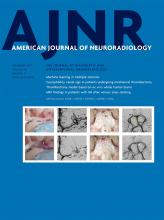Dysembryoplastic neuroepithelial tumors (DNETs) in the septum pellucidum are now considered a distinct type of lesion: myxoid glioneuronal tumors (MGTs). On the basis of DNA-methylation profile differences between these 2 entities, the c-IMPACT-NOW1 update 6 decided to call this new entity, MGT. Initially described in 2018, MGTs are slow-growing lesions that involve the anterior septum pellucidum.2 MGTs have a mutation in the PDGFRA gene that is unique to them. Included in the family of “neuronal and mixed neuronal-glial tumors,” they are considered grade I by the World Health Organization and thus are cured by complete surgical excision.
The differential diagnosis includes subependymoma, central neurocytoma, and colloid cyst. Based on the scant literature available, MGTs are adult lesions and distinguishable from subependymoma because the latter tends to arise mostly in the fourth ventricle in this age group. Central neurocytoma is a solid cystic mass that shows variable contrast enhancement, but the latter is not present in MGT. While colloid cysts are midline lesions, MGTs are eccentric. Nevertheless, MGTs have a cystlike appearance and may be confused with colloid and simple ependymal cysts.
In fact, in 3 recent cases seen at our institution, the initial impression on MR imaging studies was intraventricular cyst. Re-appraisal of the studies showed that MGTs are solid masses if findings in all sequences are correctly interpreted. Although MGTs show low T1 and high T2 in a cystlike fashion, they show high FLAIR signal (especially in the periphery, similar to that in DNET) and are solid on high-resolution heavily T2-weighted sequences such as CISS and FIESTA (Figure).3 In accordance with the findings in a small published series, none of our cases showed contrast enhancement.4 In that publication, contrast-enhanced was normal, but arterial spin-labeling showed mildly elevated perfusion.4 Susceptibility images showed no blood or calcium, a finding similar to that in our cases. In 1 case, MR spectroscopy showed low NAA but normal choline and creatine levels.4 FLAIR images may show artifacts in a location similar to that of MGT, and although artifacts are commonly bilateral, they can also be unilateral. These artifacts show a mixed FLAIR signal, while MGTs show high signal probably due to mucinous contents.
A 15-year-old boy presenting with migraines (A–C). Axial T2- and postcontrast T1-weighted images (A and B) show a cystic-appearing mass in the right lateral ventricle (arrows) without contrast enhancement. The mass appears solid on the CISS sequence (C). There is obstructive ventriculomegaly. Axial T2-weighted (D), FLAIR (E), and CISS (F) sequences in a 24-year-old asymptomatic woman. Images show a similar mass in the right lateral ventricle with a bright rim on FLAIR (E, arrowhead) and a solid texture on CISS (F).
In conclusion, neuroradiologists need to be aware of MGT, a newly recognized neoplasia. This new entity is important to keep in mind when lesions in the frontal horns of the ventricles have a cystlike appearance. Their features on FLAIR and heavily weighted T2 images suggest the diagnosis, alert the neuropathologist, and may influence treatment.
- © 2021 by American Journal of Neuroradiology













